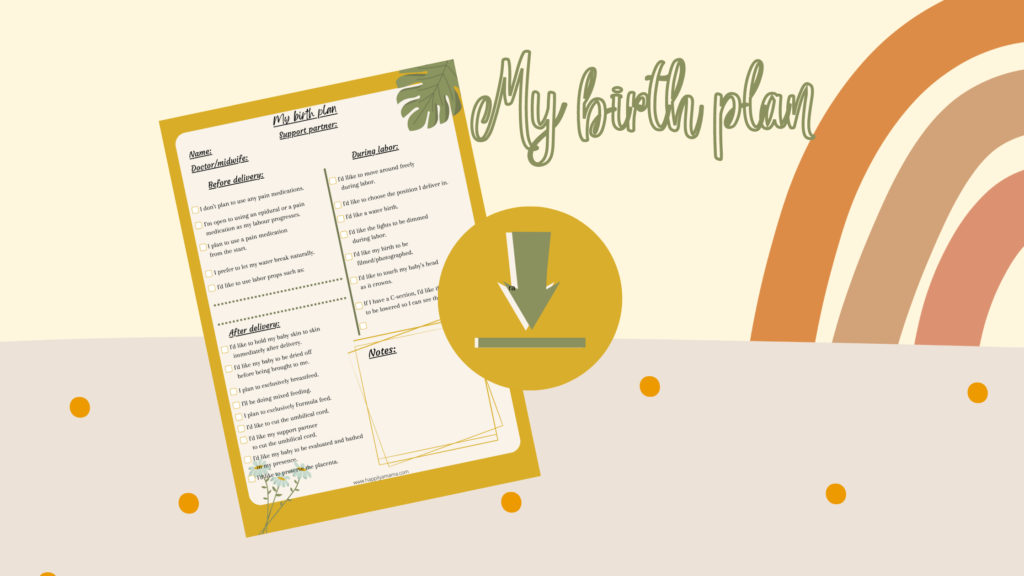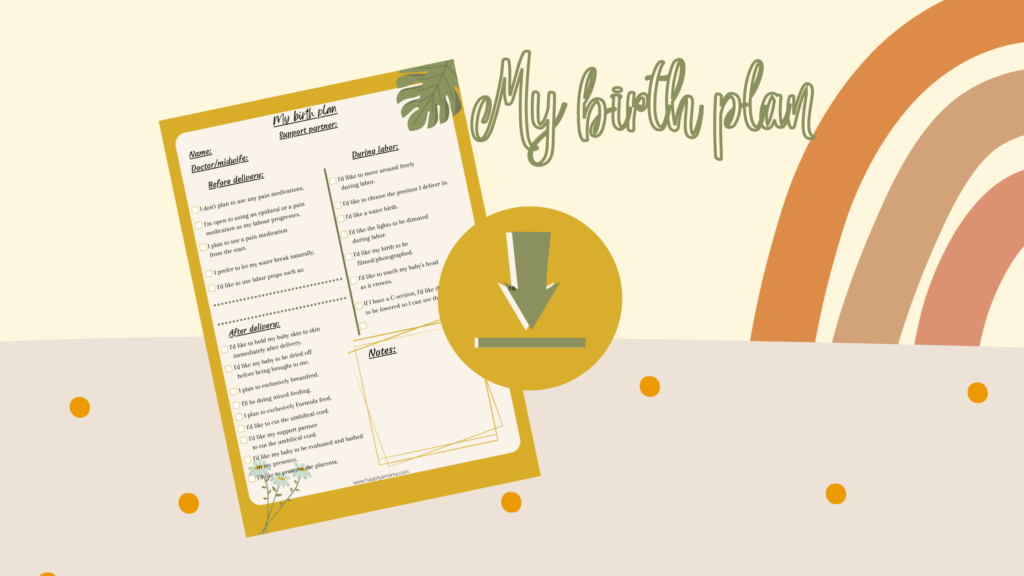Birth plan? Do people really plan a birth? The answer is: Yes, you can plan your birth. It’s quite beneficial for you to go into labour knowing what to expect. Although you can never predict how your birth is going to be, having an idea of how you wish your birth to go, will prepare you for a better birth experience. Things can go wrong and can go against the plan, that’s normal. But being prepared is way better than being unknowledgeable.
For first time moms who have no idea what and what not to do, and how things are going to look like before, during and after labour. It’s going to be quite informative and helpful to have an idea of how to communicate better with the delivery nurse, and those who are present in the delivery room. That applies even to second-time moms. Any woman can plan her birth no matter how many deliveries she’s been through. Remember, every pregnancy is different.
You can actually miss out on a lot of memorable great experiences during labour if you do not know your rights and what you can get or do during labour.
Contents
What’s a birth plan
A birth plan is a list of information that you provide to your nurse through which you express and communicate your wishes and preferences for when the time of labour comes.
Why do I need a birth plan?
Although you can do just fine without one and your delivery will go smoothly, either way, a birth plan can be handy and you’ll never regret having one. It’ll communicate your needs for you when you are in the midst of labour. A birth plan will let everyone who attends the delivery know exactly how you want things to go. That way, nobody has to make assumptions and decisions on your behalf.
What should I write in my birth plan?
Don’t worry mama! I’ve got you covered. I’ve made a ready template for you where you can just tick boxes. That template has all the options that I think are important to consider before, during and after labour. You can receive it for free straight to your inbox if you want by signing up below. But I’m going to walk you through it just in a sec.

What should be on my birth plan?
First things first, you need to write your name, your midwife/doctor’s name and your support partner’s name.
Before labour:
- Pain medication:
Are you planning to have an unmedicated all-natural delivery? Then you need to tick that option but if you’re open to an epidural or any other forms of painkillers as your labour progresses then tick the box that says so. Or you can go straight and say that you want pain medication right from the start. You choose what’s best for you.
- Amniotic fluid(breaking your water):
If you wish your water to break naturally then you need to say so. The midwife may say that she’ll break your water when it’s still safe for you to continue with your pregnancy for a few more days. It’s great to communicate with your midwife and she can let you know if you really need to be induced because otherwise, you’ll be at risk, or if it’s ok to let your body do its thing when the right time comes. Always follow your midwife’s advice because she knows better.
- Labour props:
So what are labour props? They are great useful labour tools that can help ease the pain and prepare you for pushing. These are the most common ones:
- Exercise/ yoga ball: probably the most famous birth prop. A birthing ball can help soften your cervix and ease the pain. You can use it to get into different positions during labour. I would say that it’s a must!
- Peanut ball: it’s similar to a yoga ball but has a peanut shape
- Hydrotherapy: it’s simply sitting in a warm bath during labour. Water can help ease the pain and relax the body.
- Diffuser: you can bring your own diffuser with you and use it to diffuse your favourite essential oil. This can help you to relax and prepare you mentally for birth.
- Partner/doula/support partner: although these aren’t tools but rather people, it’s great to have them do a back massage for you while you’re having a contraction.
- Combs: yes! The combs that you use to comb your hair with, can be used as a birth prop. Squeezing each comb on each hand with the teeth pointing towards the palm of your hands can divert the pain of contractions to your hands by creating a distraction.
Related articles:
During labour:
This is the most important part of the whole experience. That is when the action begins.
Choosing your labour position
It’s important that you make sure you know what positions are better for you and which ones can help with delivering your baby quickly. Some positions help to prevent perineal tears. And having the flexibility to move your body during labour can help ease the pain and open your pelvis.
Some of these birth positions are:
- Squatting
- Lying on your side
- The upright position
- Giving birth on all four
- Kneeling on a birthing ball
- Birthing chair or stool
- The lunging position
- Waterbirth
After delivery:
Now, the main event is done. What’s next?
There are actually so many things that’ll happen right after giving birth. Skin to skin with your baby, cutting the umbilical cord, the first feed… etc
- Skin to skin:
That’s when you hold your baby in your chest right after he’s born and get to cuddle and kiss him. It’s such an amazing experience and if you’re giving birth naturally, the nurse will likely give you your baby straight away after she wipes him.
But if you’re giving birth through a C-section the nurses may take your baby away for a while until the operation finishes. But you can make it clear that you do want to have skin to skin with your baby right after he’s born. This should be granted unless there’s a reason why they can’t. Have a discussion with your midwife and see what she can say about this.
- Drying your baby
Generally, the nurse will give your baby a good wipe before handing him over to you. But sometimes she won’t, depending on how you give birth. You can ask your nurse to make sure she dries your baby or not before labour.
- Breastfeeding
If you’re planning on exclusively breastfeeding your baby then make sure to mention that to the nurses. You might get overwhelmed by the whole experience and you may get tired after having your baby. The nurses may suggest that you do mixed feeding but you do have the right to say no.
Sometimes it can be hard to get used to breastfeeding. And your colostrum can be hard to extract at first, that’s why it’s worth asking the nurses for help. Trust me, they are more than happy to help you out, so don’t feel ashamed to ask them to extract the colostrum and feed it to your baby for you.
Or you can say that you want to do mixed feeding and you can specify as much as you can on how you want that to go.
Or simply say that you’re not breastfeeding your baby and you’re formula feeding right from the start. You do what’s best for you.
- Cutting the umbilical cord
Cutting the umbilical cord is such a great experience. If your partner is with you, then it’s such a great opportunity for him to get involved with the birth experience. But if you’re alone and you have no birth partner, then you may want to cut the cord yourself. Either way, communicate your wishes with your nurse before you deliver the baby.
- Baby bath and evaluation
The nurses will likely be taking your baby to give him a good wipe and evaluate him after the delivery in the same room you’re at. But that may not be the case sometimes. It’s worth asking your nurse about that beforehand and seeing what’s like at the hospital you’re giving birth in.
- Preserving the placenta
if you choose to preserve your placenta for whatever reason you like, you should tell your nurse beforehand. Normally, the hospital treats the placenta as medical waste. But you can choose whether you want to keep it or not. Discuss this with your midwife and see your hospital policy about this.
When should I start making my birth plan?
You can start your birth plan anytime you want during your pregnancy but it should be ready before you hit the 36 weeks mark because, by that time, your baby may show up at any time. You also want to make sure that you have enough time to discuss it with your midwife, your birth partner and anyone you wish to attend your birth.
Who do you give your birth plan to?
You can make a copy of your birth plan and give it to your delivery nurse, and keep one to yourself and your birth partner. But first, you need to discuss it with your midwife before the delivery. That way, if you do have any complications or health issues that are going to prevent you from getting those wishes, she’ll let you know and work on giving you better options that are going to suit your needs.
The takeaway
Labour is the most difficult experience a woman can go through. But it shouldn’t be chaotic or traumatic. It can be hard but peaceful at the same time. That’s the time you’re going to meet the love of your life. That is the only blind date you go into, knowing that you’re going to meet someone who’s going to steal your heart even before meeting them. That’s why it’s worth preparing for your date and making sure that everything is good.
Download your free birth plan template by clicking on the form below.

Please note: happily a mama and the materials and information it contains are not intended to, and do not constitute, medical or other health advice or diagnosis and should not be used as such. You should always consult with a qualified physician or health professional about your specific circumstances.









Pingback: 7 Body changes after pregnancy nobody talks about. - Happily a mama